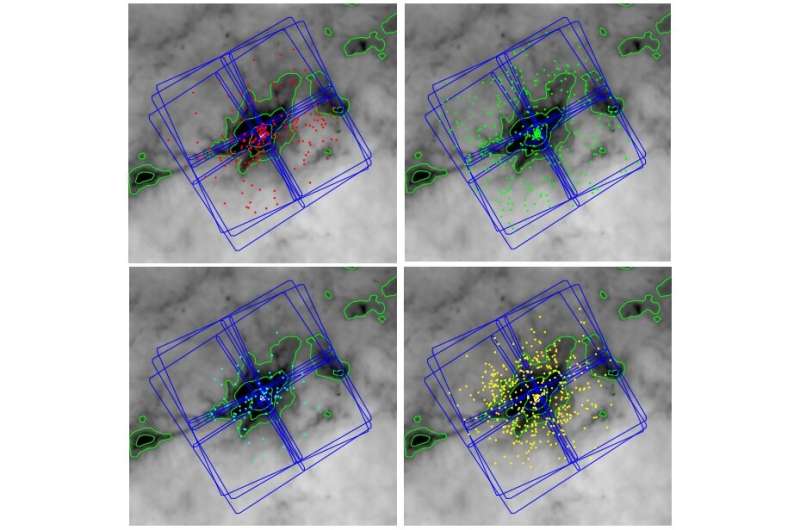Spatial distribution of four subsamples of candidate X-ray sources superposed on a Herschel SPIRE 250 µm map of the IRAS 09002-4732 region. The green contours represent infrared surface brightness levels of 500, 1000, and 3000 MJy/sr; these show the shape of the dusty cloud structures. The candidate X-ray sources are divided into subsamples and colors. Credit: Getman et al., 2019.
Using NASA's Chandra X-ray Observatory, astronomers from Pennsylvania State University (PSU) and the California Institute of Technology (Caltech) have investigated IRAS 09002-473, an embedded cluster of stars in the Vela Molecular Ridge. The study, presented in a paper published October 10 on arXiv.org, reveals more insights into the nature of this poorly studied cluster and identifies hundreds of its potential members.
Rich clusters existing within giant molecular cloud complexes hosting thousands of stars dominated by massive OB stars, could be important to better understand the process of stellar evolution. Astronomers are especially interested in studying nearby rich clusters that are now in the process of forming from infalling and merging filaments. However, such clusters are relatively rare.
Located some 5,500 light years away from the Earth, IRAS 09002-473 is one such nearby rich cluster at an early stage of evolution. Observations show that it is a young stellar cluster associated with a molecular filament several parsecs long.
Recently, a group of astronomers led by Konstantin Getman of PSU has analyzed the data from Chandra observations of IRAS 09002-473 and from optical as well as infrared surveys. This allowed them to shed more light on the properties of this cluster and to identify more than 400 probable member stars.
"Deep observations with the Chandra X-ray Observatory, combined with existing optical and infrared surveys, produce a catalog of 441 probable pre-main sequence members of the region," the astronomers wrote in the paper.
The study measured magnetic activity, age, and disk presence for the 441 individual stars. It was found that the stars from the sample have a distinctive bipartite spatial structure. In particular, the majority of the newly identified members resides in a compact, elliptical region with core radius of about 0.33 light years. However, some of them are seen in a loose, highly elongated distribution oriented northwest-southeast around the cluster.
The astronomers noted that the observed spatial structure seems to confirm that IRAS 09002-473 is associated with a molecular filament that connects to the nearby, and larger, molecular cloud. This cloud is also hosting another rich young cluster known as RCW 38.
In general, the stellar population of IRAS 09002-473 was found to be remarkably large. The researchers calculated that the cluster could have 5,000 stars. Its core turned out to be incredibly dense, with approximately 150,000 stars/parsec3. Moreover, the results show that the stellar population is heavily absorbed with median absorption at a level of about 13 mag.
The study also found that the average age of the member population is below 800,000 years. However, the researchers added that the filament-associated elongated population of stars could be even younger.
Summing up the results, the researchers say that when it comes to morphology and stellar population, IRAS 09002-473 resembles some of the richest young clusters located nearby, like Orion Nebula Cluster, Trumpler 14, NGC 6611, M 17, W3 Main and RCW 38. However, IRAS 09002-473 and RCW 38 were found to be younger, more heavily absorbed, and with higher ellipticity than other clusters of this type in the solar neighborhood.
More information: IRAS 09002-4732: a laboratory for the formation of rich stellar clusters, arXiv:1910.04873 [astro-ph.SR] arxiv.org/abs/1910.04873
© 2019 Science X Network
























